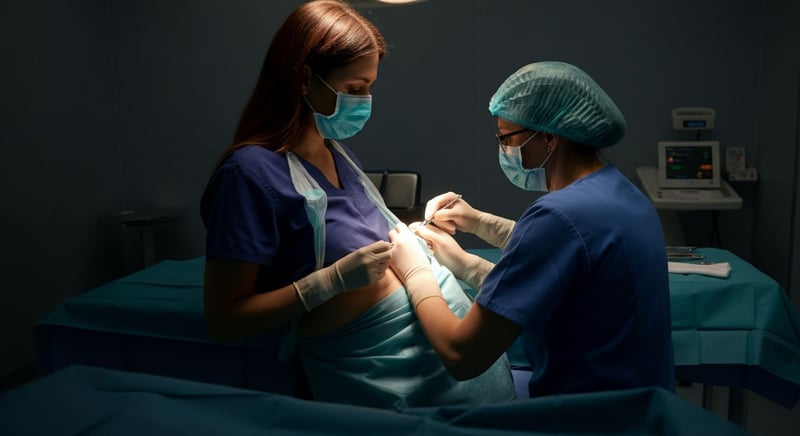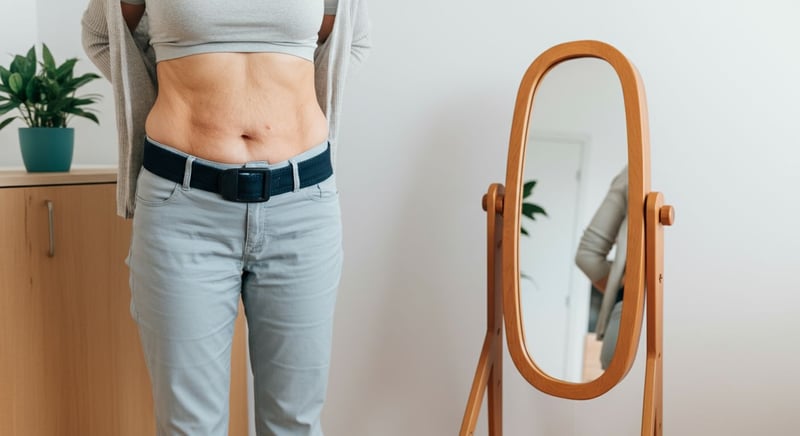Tummy Tuck Transformation: Your Ultimate Guide to a Flatter You
Learn how a tummy tuck can transform your body and boost your confidence. Discover essential recovery tips and expert insights.
Discover the transformative effects of a tummy tuck, a popular surgical procedure designed to help you achieve a flatter, firmer abdomen. With modern techniques and approaches, tummy tucks have become safer and more effective than ever. Whether you're considering this surgery for cosmetic or health reasons, it's essential to understand the process, benefits, and recovery phases involved. This comprehensive guide will take you through everything you need to know about tummy tucks, from considerations to the rewards of undergoing this life-enhancing procedure.
What is a Tummy Tuck and How Can It Reshape Your Body?
Understanding the Transformation Through Tummy Tuck
A Tummy Tuck, medically termed abdominoplasty, meticulously addresses abdominal contours by surgically removing surplus fat and skin. This transformative procedure concurrently tightens weakened or separated muscles, crafting a more refined and firm abdominal appearance. While many strive for a toned abdomen through fitness routines and diet, these efforts sometimes fall short, leading individuals, even those with balanced body weight, to seek surgical intervention.
The desire for a flatter stomach can be influenced by several factors that impact the body's natural structure. These include genetic predispositions affecting fat distribution and skin elasticity, the natural aging process that reduces skin firmness, the stretching of abdominal muscles and skin during pregnancy, and the lasting impact of previous surgeries in the area. Significant weight changes can also leave residual skin laxity, making abdominoplasty a comprehensive solution for targeted body contouring.
Ideal Candidates and Expected Outcomes
Abdominoplasty is particularly beneficial for individuals who have experienced significant weight loss or women who have undergone multiple pregnancies and are left with stretched abdominal muscles and excess skin. The procedure not only removes unwanted tissue but also reinforces the abdominal wall, which can be weakened over time. This can significantly improve posture and reduce back pain associated with weakened abdominal muscles. Diastasis Recti Repair is an important treatment for the tummy tuck procedure.
The goal of a tummy tuck is to restore a smoother, more toned abdominal profile that complements an individual's overall body shape. The results can enhance self-esteem and body image, offering a renewed sense of confidence. For example, a 45-year-old woman who had twins and struggled with sagging abdominal skin after her pregnancies sought a tummy tuck to regain her pre-pregnancy figure. Similarly, a 50-year-old man who lost a significant amount of weight found that a tummy tuck helped remove the excess skin that diet and exercise couldn't address. For someone considering body contouring, exploring a tummy tuck can be a pivotal step towards achieving their aesthetic goals.
Benefits of a Tummy Tuck
- Improved abdominal tone and shape.
- Removal of excess skin and fat.
- Repair of weakened or separated abdominal muscles.
Factors Influencing a Tummy Tuck Decision
- Assessing eligibility through a medical evaluation.
- Understanding the surgical techniques.
- Setting realistic expectations for recovery and final results.

Tummy Tuck vs. Abdominoplasty: Understanding the Differences
Decoding Terminology: A Clear Distinction
While both terms aim to provide a more contoured abdomen, the extent of surgical intervention differs. A full tummy tuck typically addresses the entire abdominal area, from the ribcage to the pubic bone, involving the tightening of abdominal muscles and the removal of excess skin and fat. This is often best for individuals with significant skin laxity due to weight loss or pregnancy. For instance, a 55-year-old woman might choose a full tummy tuck after significant weight loss to remove a large amount of excess skin, while a 60-year-old man may consider it to correct muscle laxity developed over time. In contrast, a mini tummy tuck focuses primarily on the area below the navel, making it suitable for those with less pronounced skin or muscle issues, it can be an effective option for individuals with mild skin sagging in the lower abdomen.
The choice between a full and mini abdominoplasty depends largely on the degree of correction needed and the patient's specific goals. The mini procedure involves a shorter incision and may result in a quicker recovery time, making it a potentially appealing option for those with minor aesthetic concerns in the lower abdomen. For example, someone who has undergone a cesarean section may opt for a mini tummy tuck to address the resulting lower abdominal bulge. Understanding these distinctions is crucial for setting realistic expectations and selecting the most appropriate surgical approach.
When Is a Mini Tummy Tuck Sufficient?
A mini tummy tuck is typically sufficient for those who have good muscle tone above the navel but possess excess skin or fat below it. This procedure is less invasive, focusing only on the lower abdomen, and can often be performed with a shorter incision and reduced recovery time. Ideal candidates might include those who have experienced minor weight fluctuations or women who have had a single pregnancy, resulting in a small degree of skin laxity. For instance, a 35-year-old woman after one pregnancy might choose a mini tummy tuck to address the remaining pouch, whereas a 40-year-old could consider it after noticing slight sagging due to aging.
A mini tummy tuck does not address the muscles above the navel or involve repositioning the belly button, making it an unsuitable option for those needing extensive muscle repair or significant skin removal across the entire abdomen. Those considering a mini procedure should have realistic expectations regarding the limited scope of the surgery. Consulting with a qualified surgeon to assess individual needs is crucial in determining whether a mini tummy tuck is the right choice. Typically, patients who are near their ideal weight and have localized issues in the lower abdomen are the best candidates for this less extensive approach. The procedure is often favored by those seeking a less invasive option with a quicker return to daily activities.
Key Factors to Consider
- Muscle laxity affects the choice between full vs. mini tummy tuck.
- The volume of surplus skin and fat dictates the surgical need.
- Individual aesthetic desires and physical goals must align.
Procedural Differences
- Full tummy tuck focuses on the entire abdominal area while the mini tummy tuck focuses solely on the lower abdomen.
- Incision length and extent of muscle repair are minimized with a mini tummy tuck.
- Expected recovery duration is typically shorter with a mini tummy tuck.

Diastasis Recti Repair: Restoring Core Strength Post-Tummy Tuck
The Role of Tummy Tuck in Correcting Diastasis Recti
Diastasis recti occurs when the rectus abdominis muscles, which run vertically along the front of the abdomen, separate, leading to a bulge in the abdominal area. This condition is frequently observed following pregnancy or significant fluctuations in weight. A tummy tuck often includes the crucial repair of diastasis recti, effectively addressing not just the aesthetic concern but also the functional implications of muscle separation. By surgically drawing the separated muscles back together and securing them, surgeons can restore the integrity of the abdominal wall. This process refines the abdominal profile and significantly enhances core strength and stability.
Beyond aesthetic improvements, correcting diastasis recti through abdominoplasty can lead to improved posture and reduced lower back pain, common issues associated with weakened abdominal support. For example, a 40-year-old woman who has had multiple pregnancies might find that correcting this separation not only flattens her stomach but also alleviates chronic back discomfort. Similarly, a 50-year-old man who has lost a substantial amount of weight might opt for this repair to improve his posture and overall core stability. Individuals undergoing a tummy tuck at estethica Global benefit from an integrated approach that addresses both appearance and physical well-being, ensuring a holistic improvement in their quality of life. Remember, Diastasis Recti Repair is integral to the tummy tuck procedure.
Benefits of Muscle Repair During a Tummy Tuck
Repairing diastasis recti during a tummy tuck not only tightens the abdominal muscles but also enhances the overall effectiveness of the procedure. This simultaneous correction creates a firmer abdominal wall, which contributes to a more defined waistline and improved body contour. Muscle repair can also improve core function, which is essential for physical activities and maintaining proper body mechanics. For instance, a 35-year-old athlete might choose to undergo this repair after pregnancy to regain her pre-pregnancy fitness level. Similarly, a 60-year-old individual might find that correcting diastasis recti improves their balance and ability to perform daily tasks with greater ease.
During the abdominoplasty procedure at estethica Global, the focus extends beyond aesthetic enhancements. The repair of the abdominal muscles helps to restore the natural support structure of the torso, leading to long-term benefits for posture and physical well-being. Patients often report an increased ability to engage in physical activities, reduced back pain, and an overall improvement in their quality of life. Ultimately, the combined approach of skin removal and muscle repair offers a transformative outcome, aligning physical health with aesthetic satisfaction. Individuals seeking abdominoplasty for body contouring should consider the benefits of muscle repair for enhanced outcomes, especially when considering Diastasis Recti Repair.
Advantages of Correcting Diastasis Recti
- Restoration of core strength and stability.
- Improvement in posture and reduction of back pain.
- Enhanced abdominal contour and waistline definition.
Surgical Techniques for Muscle Repair
- Suturing the separated muscles together to restore the abdominal wall.
- Strengthening the abdominal fascia for improved support.
- Ensuring proper muscle alignment for optimal functional outcomes.

Beyond the Incision: Navigating Tummy Tuck Recovery for Optimal Results
Essential Steps for a Smooth Recovery
Recovering from a tummy tuck is a comprehensive process that involves diligent aftercare to ensure the best possible outcome. Walking periodically after surgery is vital as it supports healthy circulation and diminishes the chances of blood clot formation. Compression garments play a crucial role in minimizing swelling and providing stability to the newly contoured abdomen as it heals. A structured dietary plan, abstaining from intense physical activities, and attending regular check-ups with medical professionals are key components of a successful recovery. For example, a 50-year-old patient might find that adhering to post-operative guidelines carefully helps in achieving a smoother recovery with minimized complications, while a 40-year-old, keen on resuming workouts, appreciates gradual reintroduction of exercises for sustained outcomes. Paying close attention to these guidelines can significantly impact the final results.
Patients should maintain open communication with their surgical team, promptly reporting any concerns or unexpected changes during their recovery to ensure early intervention and appropriate management. For example, if a patient experiences excessive swelling or unusual pain, immediate consultation with their surgeon is necessary to rule out potential complications. It’s important to acknowledge that each patient's healing timeline may vary but consistent adherence to the post-operative plan is crucial in achieving desired results and ensuring overall well-being. Remember, the ultimate goal is a safe and satisfying transformation.
Navigating Your Abdominoplasty Journey: The Stages of Recovery
The journey to full recovery following an abdominoplasty can be effectively managed by understanding the distinct stages involved. Initially, the focus is on pain management and wound care, typically lasting the first few weeks. As swelling subsides, attention shifts towards gradually increasing physical activity and monitoring for any signs of complications. A balanced diet rich in nutrients supports the healing process, while avoiding strenuous activities prevents unnecessary strain on the surgical area. For instance, a 35-year-old mother might initially prioritize adequate rest and gentle movement, while a 65-year-old individual might focus on maintaining a healthy diet to facilitate healing. Every stage requires a tailored approach and diligence.
Long-term recovery involves maintaining a healthy lifestyle to preserve the results of the tummy tuck. This includes regular exercise to maintain muscle tone and a stable weight to avoid stretching the skin. Continued follow-up visits with the surgeon help monitor progress and address any concerns that may arise. For instance, incorporating core-strengthening exercises, like Pilates can support the abdominal structure, while maintaining a consistent weight prevents recurrence of skin laxity. Long-term success depends on proactive care and lifestyle choices.
Key Elements of Recovery
- Gentle mobility enhances circulation and reduces risks.
- Compression garments diminish swelling and provide contour support.
- Specialized care is critical for ideal results.
Phases of Recovery After Abdominoplasty
- Initial Care involves efficient pain and wound management.
- Gradual Activity engages increased physical activity.
- Healthy Lifestyle maintains long-term results.
Expert Abdominoplasty with Diastasis Recti Repair
estethica specializes in advanced abdominoplasty techniques, including full and mini tummy tuck procedures tailored to individual patient needs. A key focus is the repair of diastasis recti, restoring core strength and abdominal wall integrity through meticulous surgical methods.
The surgeons at estethica possess extensive experience in body contouring procedures, ensuring comprehensive assessment and personalized surgical plans. They stay abreast of the latest advancements in abdominoplasty to deliver optimal aesthetic and functional outcomes for their patients. The approach integrates aesthetic goals with physical well-being, enhancing posture and reducing back pain associated with weakened abdominal muscles.
Commitment to Comprehensive Tummy Tuck Recovery and Long-Term Results
estethica emphasizes a holistic approach to tummy tuck recovery, providing patients with detailed post-operative care instructions, including recommendations for compression garments, gentle mobility, and dietary guidelines. Open communication and regular check-ups ensure patient safety and satisfaction throughout the recovery process.
Patients at estethica consistently report enhanced self-esteem and body image following abdominoplasty. The combination of skin removal, muscle repair, and comprehensive aftercare results in a transformative experience, aligning physical health with aesthetic desires and increasing patients' ability to engage in physical activities with greater ease.
Frequently Asked Questions
What is a Tummy Tuck (Abdominoplasty) and what are its benefits?
How does a Tummy Tuck address Diastasis Recti Repair?
What is the difference between a full and a mini Tummy Tuck?
What should I expect during the recovery after a Tummy Tuck?
How can I maintain the results of my Abdominoplasty long-term?
Ready for a healthier, more beautiful you? Contact estethica for expert aesthetic and healthcare solutions.
📞 Call for Your Free Consultation!